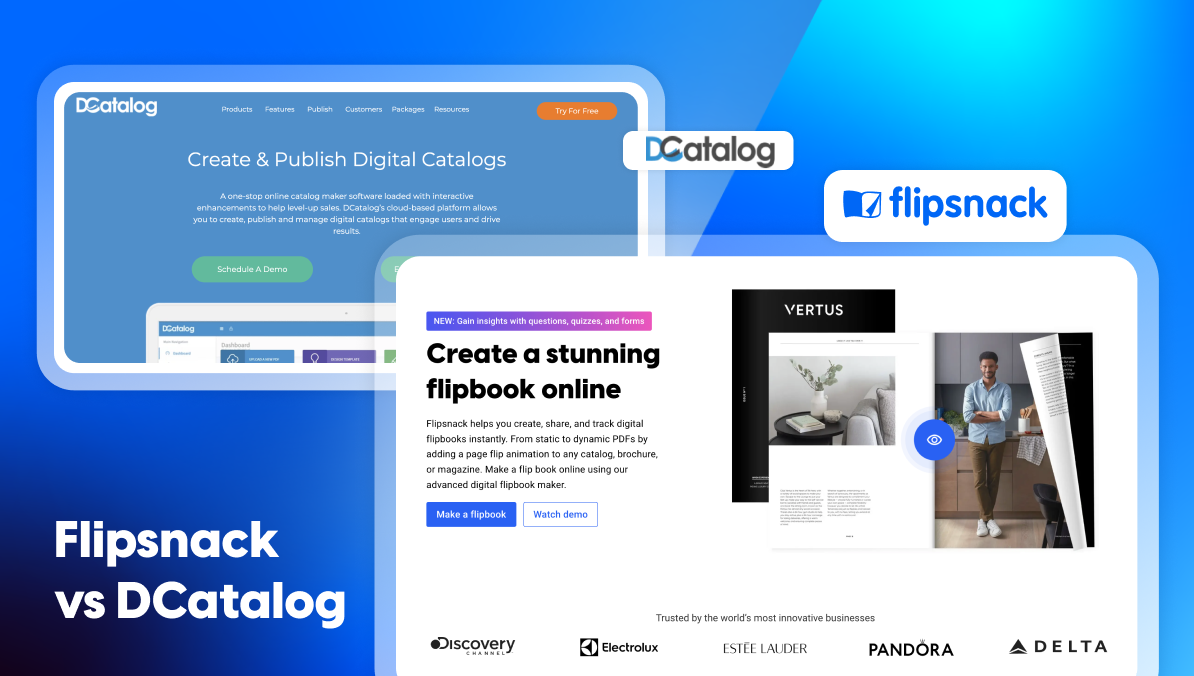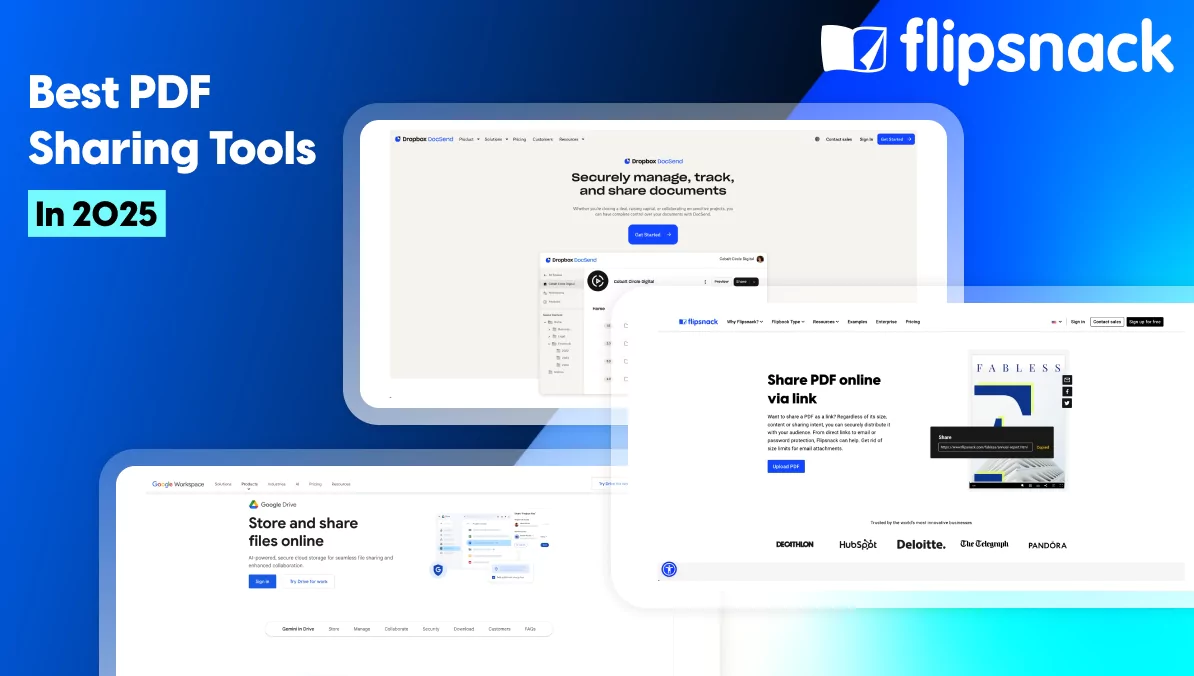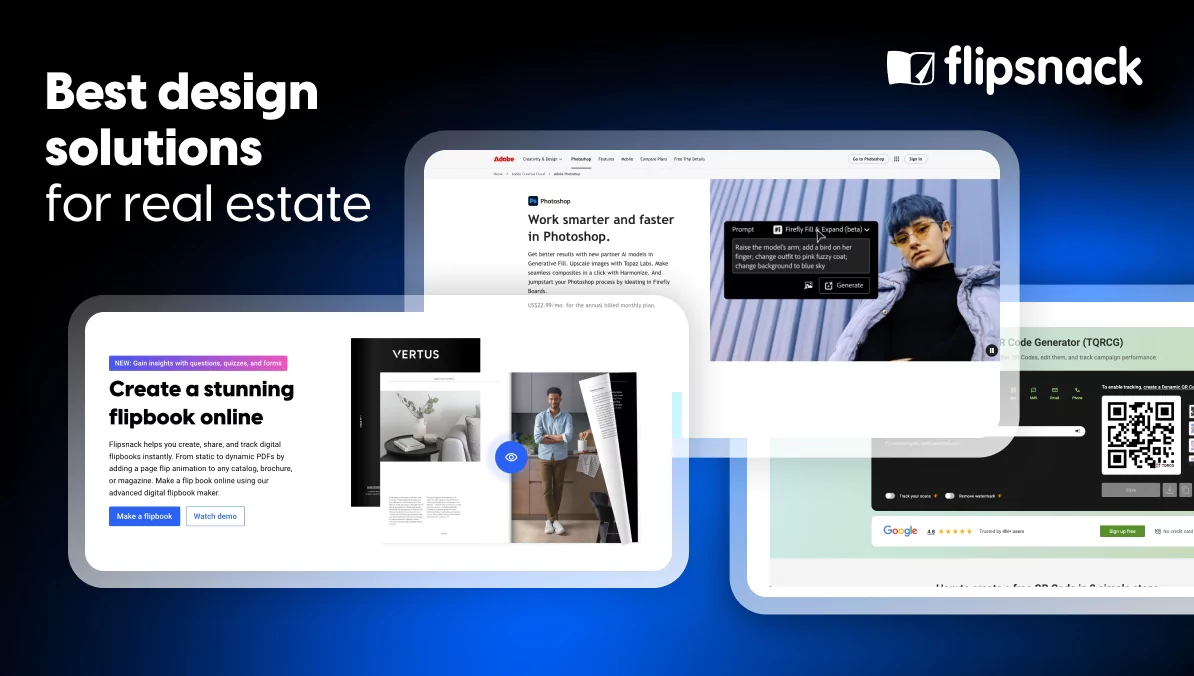Flipsnack vs. DCatalog: Which Platform is Best for Product Catalogs?
Printed and static PDFs no longer cut it for enterprise product communication.
Marketing and sales teams today need interactive, data-driven, and always up-to-date catalogs that can engage buyers, simplify collaboration, and accelerate revenue across regions and channels.
For companies managing large product inventories – manufacturers, wholesalers, retailers, and service providers – traditional catalog creation methods are becoming a bottleneck. Manual updates and static designs can’t keep up with modern buyers’ expectations or the fast pace of digital commerce.
To stay competitive, catalog publishing must now align with broader digital transformation goals:
- Speed and accuracy in updates so every product detail stays current
- Engagement-rich experiences that capture attention and drive action
- Automation and integrations to streamline workflows and data management
- Collaboration and security across distributed marketing, design, and sales teams
That’s where modern digital catalog platforms come in. Two catalog makers frequently surface in enterprise conversations: Flipsnack vs. DCatalog.
Both convert PDFs into interactive product catalogs, but they serve different business needs. Choosing between them isn’t about which tool has more features; it’s about which one aligns with how your team works and what your catalog strategy needs to achieve.
Flipsnack vs DCatalog: Which one is the best for your business?
| Flipsnack | DCatalog | |
| What is best for | Interactive, marketing-driven, sales catalogs and brochures | Automated, data-driven product catalogs with deep e-commerce |
| Ideal users | Marketing managers, designers, sales enablement teams | Enterprise IT, e-commerce, and operations teams |
| Ease of use | Intuitive, no-code design studio | Technical setup with a steeper learning curve |
| How it automates | Content synchronization and real-time updates | Full data-to-catalog generation from PIM/ERP |
| E-commerce | Shoppable links, quote forms, wishlists | Integrated cart and checkout inside the catalog |
| Pricing | Transparent SaaS tiers with scalable enterprise options | Custom quote-based, higher total cost of ownership |
Flipsnack vs DCatalog: Which one is the best for your business?
That balance between creativity and consistency is why global brands like Electrolux, Pandora, and Melissa & Doug trust Flipsnack to design, publish, and scale digital catalogs that stay true to their brand, every single time.
Now that we’ve covered the big-picture differences, let’s take a closer look at what really matters when choosing a digital catalog maker. Below is a detailed comparison of how Flipsnack and DCatalog perform across the key areas that shape your product catalog strategy, from interactivity and automation to collaboration, security, and brand control.

1. Interactive catalog: engage buyers beyond PDFs
Modern buyers expect more than static product listings. They want immersive digital experiences, interactive media, videos, links, and direct purchase paths.
Flipsnack excels in this space with its drag-and-drop Design Studio and a library of interactive elements:
- Embedded videos, galleries, GIFs, and audio
- Product tags and shopping lists for easy browsing
- Lead capture forms integrated with HubSpot or Salesforce
- Clickable CTAs and hyperlinks for frictionless user journeys
Flipsnack doesn’t stop at interactivity; it bridges the gap between browsing and buying. Your catalogs can include multiple checkout options to match different buyer behaviors:
- Email checkout – orders go straight to your sales team’s inbox
- WhatsApp checkout – enables conversational commerce with quick clarifications
- Shopify integration – connects to your webshop for instant cart and payment flow
- PDF/CSV downloads – for B2B buyers needing procurement-ready lists
- Wishlists – allowing customers to save favorites and send them for follow-up or in-store purchase
These features make Flipsnack ideal for B2B and B2C marketing catalogs, lookbooks, product booklets and presentations, all while maintaining a polished, brand-consistent aesthetic.
DCatalog also offers interactivity, but its strength lies in embedded transactions. Buyers can add to cart and complete checkout directly within the catalog viewer, useful for wholesale and distributor workflows.
If engagement and brand storytelling, plus shoppable catalogs, matter most, choose Flipsnack. If in-catalog purchasing is the only thing important, DCatalog can be the choice.
2. Automation and real-time updates
For companies managing thousands of SKUs, automation is no longer optional. It’s the key to keeping catalogs accurate, fast, and easy to update.
With Flipsnack, product data and design work together seamlessly. You can link your catalog directly to a spreadsheet, CSV, or system export, so every price change, promotion, or new product appears automatically, without rebuilding pages from scratch. This simple connection saves hours of manual work and helps you avoid costly mistakes caused by outdated files.
Automation in Flipsnack goes beyond updating data. It helps you create, organize, and publish catalogs at scale while maintaining a consistent brand look. You can:
- Generate a full catalog from your product feed, with live data mapped into your layouts.
- Update existing catalogs instantly whenever your spreadsheet changes.
- Automate multimedia elements, like product images, videos, pop-ups, or links.
- Make catalogs shoppable, combining automation with wishlists, quotes, or checkout flows.
Our design team can make custom-branded Catalog Generator templates made for your business or specific use case. These templates can highlight your unique brand identity, incorporate specialized product layouts, and ensure every catalog feels professional, consistent, and uniquely yours.
Also, Flipsnack integrates with Zapier, Google Analytics/Tag Manager, Adobe InDesign, etc., to fit into marketing workflows.
DCatalog, by contrast, focuses on large-scale automation. It can regenerate catalogs automatically from PIM or ERP feeds, which makes sense for enterprises handling massive, complex inventories across multiple regions or divisions. Out-of-the-box integrations (Zapier, etc.) are fewer, but they offer custom integration support for enterprise needs
In short, Flipsnack helps you update smarter, while DCatalog helps you generate faster, two different approaches to automation designed for different types of teams and business needs.
3. Collaboration and better workflows
For enterprises with cross-departmental collaboration, marketing, design, sales, and IT, workflow control is key.
Flipsnack offers a complete collaboration suite:
- Multi-workspace environments (e.g., by brand or region)
- Role-based access (viewer, editor, admin)
- In-catalog commenting and approval workflows
- Version control with link persistence—update content without breaking URLs
- Single Sign-On (SSO) and audit logs for compliance
In contrast, DCatalog offers multi-user access (allowing unlimited team members), but collaboration features are more basic. Does not have the same in-app commenting or live co-editing capabilities as Flipsnack. Users note that the UI/workflow can feel clunky at times, suggesting it’s less focused on interactive teamwork and more on the generation of the catalog content itself. Most workflow coordination happens outside the platform (via email or project tools). Flipsnack supports creative and approval workflows natively, ideal for marketing and sales enablement teams.
4. Security, compliance, and scalability
When it comes to digital publishing, trust is everything. Both Flipsnack and DCatalog meet enterprise-grade security standards, but they take different approaches to protecting your data and content.
Flipsnack: Enterprise security you can rely on
At Flipsnack, security isn’t just a feature; it’s a commitment. Every piece of data shared on the platform is protected through audited, verified, and certified protocols, ensuring compliance and peace of mind.
Flipsnack holds multiple international certifications:
- ISO 27001, ISO 9001, and ISO 20000-1 — information, quality, and IT service management.
- CSA STAR and Data Privacy Framework certifications.
- GDPR and HIPAA compliance, meeting global privacy requirements.
Flipsnack infrastructure is hosted on Amazon Web Services (AWS) within a Virtual Private Cloud (VPC), featuring:
- 256-bit TLS/SSL encryption and encrypted credential storage.
- Zero Trust architecture and least-privilege access for employees.
- Disaster recovery across three AWS availability zones.
- 99.9% uptime monitoring and continuous system audits.
Enterprise clients benefit from:
- SSO authentication for centralized access.
- Granular user roles and permissions for secure collaboration.
- 2FA enforcement and strong password policies across all systems.
Flipsnack’s approach creates a secure, scalable SaaS environment designed to grow with your organization while ensuring privacy, compliance, and creative freedom.
Flipsnack helps us improve our internal digital communication. The features in Flipsnack make our collections and functionalities come alive and intriguing, helping us promote every level of detail and design concept, as well as material innovation, to our store staff globally. From the beginning, Flipsnack has understood our priority of IT safety first, and their internal developers have worked to meet our high requirements.
Therese H. Lindeløv, Creative Content Manager, Global Product
DCatalog: Cloud and on-premise security
DCatalog also prioritizes security, offering password-protected content, SSO, and ERP/DMS integration for user authentication. The platform can be deployed on private cloud, Amazon S3, or even on-premise for companies that cannot use public hosting.
It includes user and subscriber management, custom login screens, and controlled access for different audiences, ideal for enterprises needing strict internal data control and dedicated hosting environments. If your priority is audited, certified, and globally compliant SaaS security, Flipsnack offers the right mix of scalability, reliability, and peace of mind.
If your organization requires on-premise or private cloud deployment, DCatalog provides that infrastructure flexibility.
5. Pricing and value
Pricing transparency and scalability are critical for SMB and enterprise teams evaluating ROI. Flipsnack offers clear tiered plans:
- Starter: $35/month
Professional: $52/month - Business: $109/month
- Business Team (5 users): $319/month
- Enterprise: Custom pricing with API, SSO, and unlimited users
DCatalog uses a quote-based model, often charging per active catalog link, which can escalate for companies publishing many catalogs.
Flipsnack delivers faster ROI and predictable pricing. DCatalog’s bespoke model suits companies with deeper automation budgets.
6. Branding control over your catalogs
We know a catalog is not only a sales tool but also a reflection of your brand. Every color, font, and layout shapes how customers see your products and your company. For most marketing and design teams, keeping that identity consistent across digital and printed catalogs is essential.
Flipsnack makes it easy to design interactive catalogs that stay on brand while giving teams full creative control. You can:
- Use your own domain for branded catalog links and remove Flipsnack from URLs.
- Upload brand assets like logos, fonts, and colors into a shared brand library.
- Lock templates to keep layouts and visual elements consistent across teams.
- Assign roles and permissions to ensure only approved users make changes.
- Send branded emails and links so every viewer experiences your identity.
DCatalog also offers ways to maintain brand identity, especially for enterprises using automated catalog production. You can:
- White-label publications and remove DCatalog branding.
- Create branded templates aligned with your corporate style guide.
- Use custom domains for a professional, on-brand viewer experience.
- Host branded catalog sites that integrate with your existing systems.
7. Support and onboarding
Adopting a new tool can feel overwhelming, especially when your team is already juggling tight deadlines, complex product data, and existing workflows. We know how hard it can be to introduce new software and expect everyone to make it work seamlessly right away.
That’s why Flipsnack offers guidance and support every step of the way.
Enterprise customers receive a Dedicated Success Manager, custom onboarding, and priority support, ensuring your team feels confident and capable from day one.
Our specialists work alongside you to help set up data feeds, automate updates, and create catalog templates that fit your brand and process. It’s no surprise that Flipsnack’s support is praised for its speed, empathy, and hands-on approach (9.6/10 on G2).
DCatalog, on the other hand, is known for its “White Glove” service. Their team handles catalog setup, link management, and integration configurations directly. It’s a great option if you prefer a done-for-you approach rather than an internal enablement model.
In short, Flipsnack empowers your team with ongoing support, while DCatalog handles setup on your behalf. Both approaches offer value; the right choice depends on whether you want control and learning within your team or an external partner managing the process for you.

Why Flipsnack is the smarter move for product catalogs
Flipsnack is built for teams that value speed, control, and impact. It’s more than a flip viewer; it’s an all-in-one environment for designing, automating, and publishing professional, interactive catalogs that drive real results.
Choose Flipsnack when you want:
- An integrated design and publishing workspace, not just a viewer.
- Customizable interactivity and templates without relying on external designers.
- Advanced analytics and access controls for different audiences and regions.
- Seamless collaboration between marketing teams, agencies, and global branches.
- Flexible enterprise plans and dedicated support that scale with your business.
With Flipsnack, your transition is guided, smooth, and built around your team’s workflow, so you can focus on results, not complexity.
In the end, the best platform isn’t the one with the most features but the one that helps your team move faster, communicate better, and sell smarter.



